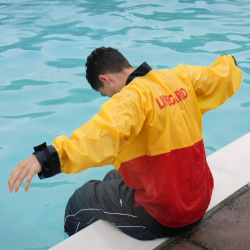Nylon
Nylon is a fine choice for a wide variety of swimwear. It is a low cost alternative to other fibres and often mixed with fibres such as Lycra or Polyester.
Nylon fibres make up the majority of most non-polyester swimwear, whether blended with Lycra, or used on its own in 100% Nylon swimwear. Most pools like Nylon swimwear as it sheds no fluff to clog up the filters.
Tough Fabric
Even though Nylon is lightweight, it remains one of the strongest manufactured fibers, an extremely tough fabric that is both tear and abrasion resistant. The main advantage is that it absorbs little water, and dries faster than other materials such as cotton. This makes it ideal for swimwear and watersports where you get wet a lot.
Wet Outdoor Actvities
Outdoor nylon fabrics have a urethane coating to repel water, making them great for watersports, hiking, and other wet activities. Nylon is popular for bags, outdoor and camping gear, tarps and protective coverings, and more.
Some drawbacks of Nylon are its lack of elasticity and its reduced ability to hold colour.
Expect some colour fading. It won't affect the performance.
Drag Suit
Looking for a great drag suit to add to your workout or swim meet warmup?
Consider an unlined Nylon anorak with matching pants. It is pleasant to swim in and dries quickly as the fabric holds little water.
The main training benefit is that it creates a lot of drag. Make sure it fits properly for best results and more fun.
Weight
Nylon fabrics come in many different deniers
which refer to the thickness of the individual fibers that make up the fabric
and is an indication of weight and durability.
The clothing industry was revolutionized in the 1930s with the announcement of polyamide (PA),
far better known by its trade name Nylon, the first purely synthetic fibre,
introduced by DuPont Corporation at the 1939 World's Fair in New York City.
Nylon fibers are very strong but also flexible. The first application was for bristles for toothbrushes. However, Du Pont's real target was silk, particularly silk stockings and soft rainwear.
Laminated Fabrics
Some garments use nylon or polyester laminated to a microporous membrane (2-ply laminate), and sometimes to an additional layer of fabric designed to wick moisture (3-ply laminate). Laminates are layers of fabrics glued or heat bonded together.
Laminates are more waterproof than coated fabrics but they tend to be a little stiffer and heavier. Examples of laminates include: Aqua-No, Bosui, Challenge, Dermizax, Gore-Tex, XALT.
Coated Fabrics
Many nylon or polyester garments use waterproof coatings made of Polyurethane (PU). Fabrics that are coated rather than laminated tend to be softer and less noisy, but not as waterproof.
We like them because they offer good value for money and last quite a long time. Some examples of coated fabrics include: Hydro-No, Power-Tex, Ultrex, Breath and Hydroflex.
Uncoated Fabrics
Uncoated fabrics are water resistant due to their tight weave, but will eventually soak through. They are breathable, windproof, soft and lightweight. Wear them for sunburn protection while swimming or enjoying the outdoors.
4oz Exeat Coated Nylon
A hydrophilic coating which permits water vapour to pass through the fabric from body side to outside thus keeping the wearer comfortable and dry.
8oz Neoprene Coated Nylon
Nylon fabric for heavy duty water clothes, ultra tough, durable fabric for serious weather conditions, wild water sports or muddy assault courses. Top performing waterwear will endure the rigours of outdoor adventures. Lifeguards wear uniforms made of this fabric.

Medium weight splash suit

Heavy duty lifeguard anorak
Silnylon
This silicon coated tent fabric is even better. It is lighter and stronger, so smart manufacturers now use it to make ponchos and rainwear.
Silnylon, a portmanteau of "silicone" and "nylon", is a synthetic fabric used mainly in lightweight outdoor gear. It is made by impregnating a thin woven nylon fabric with liquid silicone from both sides. This makes it strong for its weight, as the silicone substantially improves the tear strength.
It is also highly waterproof, but not breathable. It is used in the manufacture of backpacks, tarps and tarp tents, ditty bags, etc, particularly by ultralight backpackers.
Silnylon has taken the backpacking world by storm and comes in several main types. The common type is a quiet, silky, very slippery fabric.
The variant known as "crisp silnylon" is lighter, but brittle, noisy, and tears easily. You may want to avoid that. Better versions are made from the stronger type 66 Nylon.
Some garments are made from a blend of silicone and urethane
which is done partly to reduce the air pollution during manufacture,
as it reduces the aromatic solvents used in the coating process.